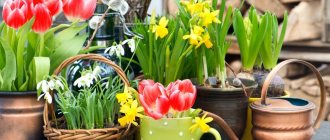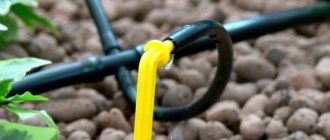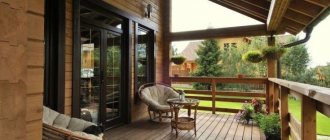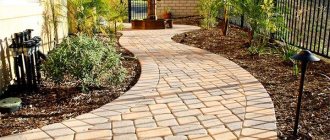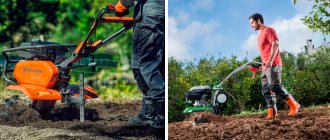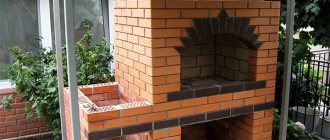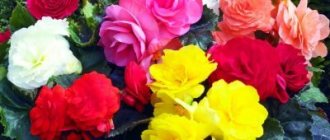Description, characteristics
A plant from the Begoniaceae genus. It is a small, decorative, green shrub with numerous carved leaves. The flowers are large, of various shades, shaped like small roses. The species received its unusual name due to the terry border on the flower petals , which gives them special tenderness and showiness.
In nature, begonia is widespread in Africa, Asia, and America. It began to be grown in domestic culture in the 17th century. Since then, quite a few different species and varieties have been obtained, differing in size, color and some features of care.
“Begonia terry mix” is more often found in specialized stores. Many designers prefer it. With its bright, varied colors it will decorate any flower arrangement.
Terry ever-blooming begonia is often confused with simple ever-blooming begonia, which lacks the characteristic terry border.
Appearance and characteristics of the plant
The begonia variety Elatior is a hybrid , bred at the end of the 19th century in England. Its ancestors were the Socotrans and tuberous varieties of begonia. In the future, this made it possible to obtain hybrids with non-trivial flowering and excellent decorative properties.
During this period, Holland is considered the mass producer of Elatior plants. There, flowers are bred in greenhouse and indoor conditions, obtaining new species that are more resistant to fungal diseases. Dutch begonias are transported to European countries, Russia, and America. Plants are used for landscaping.
The winter begonia hybrid is an annual shrub with densely flowering inflorescences. The maximum flower height reaches 40 cm .
The plant has a dense, developed stem, as well as asymmetrical heart-shaped foliage. The leaves have a rich green color on top, while the bottom part is light green. The size of the flowers is up to 8 cm in diameter.
Caring for begonia terry mix at home
Growing begonia is not difficult, although this process requires proper care, attention, care and responsibility.
Landing
At home, it is grown using tubers or seeds.
- Tubers are prepared in the fall (before the onset of cold weather). They are taken out of the ground, cleaned, and the stems are removed. Store in a cool place (+8 +11) in containers with peat or sand. Planted from mid-February to May.
- Seeds are sown in winter in a prepared mixture of leaf soil with the addition of peat and sand. The method is more troublesome and takes more time.
- If you are going to replant flowers on an open loggia, in a winter garden or a summer cottage, this should be done in early or mid-May. It is important that by this time the snow has completely disappeared from the site, the frosts have ended at night, and the earth has warmed up well in the sun during the day.
Choosing a pot
It is advisable to give preference to containers made of environmentally friendly materials - clay or ceramic pots that have porous walls and allow oxygen to pass well to the roots. Can be grown in wooden pots with good drainage. Choose a pot that is not deep (10-14 cm) .
The soil
Light, porous soil rich in minerals is suitable. Oxygen must reach the roots and moisture should not stagnate.
- You can purchase a ready-made soil mixture for growing indoor plants. Add sand or brick chips to it for good drainage.
- You can prepare it yourself from greenhouse soil for indoor flowers, sifted sand, and peat.
- Be sure to make a dense drainage mound at the bottom of the pot. Tuberous varieties are especially susceptible to flooding.
Watering
- Keep the soil moist. The top layer of soil should dry well between waterings. Stagnation of moisture can lead to rotting of the roots.
- Use only settled water at room temperature.
Light mode
Terry begonia loves good, intense lighting. But it does not tolerate direct sunlight. Its leaves are very sensitive to overheating and burns.
- In summer, create conditions for diffused lighting.
- If the flower is on the windowsill, periodically turn it with different sides towards the sun. This promotes uniform growth and flowering.
- In winter, use additional artificial lighting if necessary.
Thermal mode
- Ventilate your apartment more often. At the same time, keep the plant away from drafts, cold winds, and temperature changes.
- In warm summer weather, it will be useful to take the begonia out into the fresh air.
- In winter, the room temperature should not fall below 15 degrees.
Air humidity
Humidity should be increased. At the same time, it is not recommended to spray the flower so that brown spots do not appear on the leaves. Buy a floor humidifier, spray the air around the flower or place a container of water nearby.
Feeding
It is useful to carry out no more than once a month. Special mineral fertilizers are suitable as fertilizing.
Trimming
Begonia needs regular pruning because it grows quickly and the stems begin to rapidly stretch. It is useful to perform the pruning procedure to improve flowering, form the crown of a young plant, rejuvenate and maintain a decorative appearance.
- The first pruning begins when the stems grow to 7-8 cm. The bush needs to be shaped. After pruning, watering is temporarily reduced.
- When the side shoots reach 10-12 cm, their tops are trimmed. This will help the side kidneys wake up.
- In the future, you need to monitor the appearance of the flower. Remove dried twigs, leaves and shoots.
- Pruning is carried out only with a sharp knife. Scissors or pruning shears cannot be used. It is useful to treat cut areas with crushed charcoal to speed up the healing process.
Where and how to plant?
It is best to start planting in March, then the most beautiful blooms will fall in the warm summer period. It is better to give preference to clay and ceramic pots; they allow the roots to be saturated with oxygen.
There are several ways to plant Begonia Mix:
- When planning to plant begonia from the rhizome, do not prepare a large container. Ideally, it should be 4 cm larger than the diameter of the roots. If you choose an extremely large pot, the flower will suffer from excess moisture.
Planting in a pot is carried out, like transplanting, in the spring. Part of the container is filled with drainage. This is followed by charcoal, which helps bypass the rotting process. Afterwards, you need to mix the fortified soil with humus, sand and peat.It must be remembered that the young plant does not tolerate increased soil acidity well; it should be within 5.5 pH. The plant accepts planting positively. Over the years, Begonia thickens, growing more leaves. Flower gardeners often take cuttings or rejuvenate by dividing the rhizomes.
- For the tuber planting method, germination must first be done.
This is done by planting in a vitamin-rich environment, keeping the flower in the light at high humidity and a temperature of 18C. It is better to water in a tray, preventing water from getting into the recess on the tuber itself. After germination, they are planted in a peat pot. After waiting for the buds to appear, you can safely divide the tubers into several parts. Dry the divided parts a little, sprinkle with charcoal and plant in pots. Tuberous planting should be done at the end of March; this time is the best for the development of a strong and resilient plant.
Divided tubers bloom several weeks later.
Reproduction
Propagated by seeds and cuttings.
Propagation by seeds
- Carry out at the end of January or beginning of February.
- Select a suitable container. Drainage and soil consisting of leaf soil, sand, peat are poured onto the bottom and moistened.
- Seeds are sown on the surface, lightly sprinkled with soil.
- Grown in greenhouse conditions. Cover the top with a glass jar or film. Open once a day to allow the seedlings to breathe air and moisten if necessary. Keep at a temperature of 22-25 degrees.
- Drops will periodically form on top of the glass. They need to be wiped with a dry cloth.
- The first shoots will appear in 2 weeks.
Propagation by cuttings
- Using a knife, cut a healthy, strong leaf from the stem and place it in a container with a moistened substrate (expanded clay, perlite or moss).
- Cover the top with a glass jar or polyethylene. You can make holes in the film so that the ventilation process occurs.
- After 2 weeks, roots will appear. After another two weeks, the polyethylene is removed, and the young rooted shoots are transplanted.
Plant lifespan
Begonia can be grown either as an annual or perennial plant.
- If you grow a flower in a summer cottage or on an open loggia, the queen cells are transplanted into pots and brought into the house before the first frost. In a well-lit place, begonia can continue to bloom until spring, and then it is planted again on the site.
- If you grow begonia as an indoor flower, you need to properly care for it during the dormant period.
Selection of planting material
I buy new tubers immediately after they go on sale. As a rule, this is mid-January - early February. At first glance it may seem that I am in a hurry to buy. But as experience shows, at this time there is a much greater chance of choosing high-quality planting material, and at home trying to create optimal conditions for storage, which, unfortunately, cannot always be seen in retail outlets. There, often by spring almost completely dried and non-viable tubers are sold.
When purchasing, it is better to choose young, round tubers with a diameter of 5-6 cm.
Before planting, I use wet sawdust or moss to store purchased material. I usually store it in the refrigerator until early March.
Pests and diseases
Terry begonia is sensitive to violation of care and planting recommendations. May be susceptible to disease and pest damage.
- A white coating on the leaves may indicate powdery mildew. In this case, it is necessary to remove the damaged leaves and treat with a fungicide. Ventilate the room more often. Begonia does not like stuffy rooms.
- If clots form on the leaves and stick to your hands, the flower is damaged by aphids. Treatment with celandine infusion or onion decoction helps well.
- A thin web indicates a spider mite infestation. It often appears in apartments with dry air. Install a humidifier and ventilate the room more often. Wash the plant with a damp sponge. You can soak a cotton ball in a soap solution and carefully collect the cobwebs. Severe damage will require treatment with insecticides.
- The plant can be damaged by gray rot (especially when grown in greenhouses). High temperature with high humidity is a favorable environment for its occurrence. White watery spots with a grayish coating form on the tips of the shoots, flowers and leaves. They soon turn into brown rot. The stems rot, the leaves curl and turn black. The method of control is spraying with 1% Bordeaux mixture.
Other problems:
- If the begonia leaves begin to curl, the old leaves may be dying. This is a normal physiological process.
- If the leaves curl and darken, the begonia is not getting enough nutrients.
- Fallen and darkened leaves are the result of exposure to water or too dry air in the room. Flowers may also begin to fall off if water gets on them during watering.
Begonia Terry is preferred by many gardeners. It attracts attention with its decorative appearance and charming long-lasting flowering. If you decide to grow it at home, be sure to read the basic care recommendations. Begonia is a sensitive flower, demanding attention and care. But the work will be rewarded! If you give her your care, she will delight you for a long time and will become a real decoration of your home!
Next you will see photos of how to care for the ever-blooming terry Begonia at home:
Memo to the florist
Knowledge about the general characteristics of all types of begonias will help you properly care for them.
- The plant does not tolerate heat (above +20°C) and winter cool indoors (below +15°C).
- All begonias do best in moist air. Containers of water near the pot or misting the air close to the plant will help deal with dry air from central heating.
- Do not allow water to stagnate after watering. Watering should be plentiful.
- Begonia enjoys bright light, but not direct rays of the sun.
How to transplant nolina? Be sure to check out this material.
Why doesn't it bloom?
There may be several reasons why begonia does not bloom: lack of lighting; incorrectly selected soil mixture; incorrect transplantation; eating disorders; violation or absence of a rest period; dry air; pest damage; violation of watering (severe dryness or watering with hard water).
A few words about begonias
There is a belief that begonia has a certain magic: everyone who sees this plant falls in love with it at first sight. It is not surprising that begonia has attracted your attention. This note describes the features of caring for begonia at home. This indoor plant comes in various types, but they are all divided into flowering and decorative deciduous.
Blooming begonias are distinguished by their colorful flowers, fluffy to the touch, in various colors: from red, white, pink, yellow and their various spectral shades.
Decorative foliage crops are distinguished by a variety of colors of beautiful leaves, small flowers or their absence. The most common plant among flowering species is terry begonia mix. This exotic culture can very often be found in flower shops and, of course, it is difficult to pass by and not purchase it.
Appearance Features
It grows as a subshrub (you can find out about the varieties of bush begonia here). Well developed root system. Tuberous begonia can grow in open ground.
The lush foliage is uniformly green; the leaf itself has an asymmetrical shape with jagged edges. The flower is large, similar to a small rose. Blooming begonia mix has double inflorescences of red, yellow, pink, white flowers or with a border of various shades along the edges of the petals. You will find an overview of all varieties with bright red leaves in this article, and here we talked about the types of plants with yellow flowers.
Flowering occurs in summer and autumn, but indoor begonia can bloom until the beginning of winter.
Today, begonia is very popular and is grown both indoors and in the garden. We will tell you about other equally charming varieties of this plant, such as Diadem, Naked, Sizolistnaya, Bauer or Tiger, Collar, Coral, Fista and Masona.
Features of caring for begonia mix
If you become the owner of a flowering begonia, you need to familiarize yourself with the features of caring for this plant at home. After all, this exotic culture is very capricious. Even the time of purchase of terry mix begonia and its transportation significantly influence its adaptation to the new habitat. It is advisable not to purchase begonia during cold weather, because it may not survive sudden temperature changes between the street and the room.
It is better to place the plant on a windowsill on the southwest or southeast side to avoid direct sunlight that is undesirable for the flower. If you place the begonia correctly, then throughout the spring and summer you will watch it bloom. Closer to the cold field, the plant bulb pauses the growing season and remains dormant until it warms up.
Planting in open ground
The exotic, whose homeland is equatorial countries, will not survive the harsh Russian winter. Therefore, the flowerbed will have to be updated every year . But what an opportunity to see a variety of varieties of evergreen begonia!
Deadlines
Already grown seedlings are planted in the ground . The optimal planting time will be mid-May, when the soil has already warmed up sufficiently and the threat of recurrent night frosts has completely passed.
Selecting a location
In order for semperflorence to bloom profusely and beautifully all summer, attracting attention, you need to choose the right place on the site .
Attention! Although the everblooming begonia is native to the warmer regions of America, direct sunlight falling on the flower all day can cause burns on the delicate leaves.
You should not plant seedlings in dense shade either: such conditions will cause the sprouts to stretch out, and the flowering will be faded and indistinct.
Give preference to areas where the bright sun will illuminate the plantings before noon and after five o'clock in the evening , and in the midday heat they will be shaded.
Soil preparation
Begonia prefers loose, nutritious soil . Before planting seedlings in the ground, it is important to disinfect the soil by spilling it with a solution of potassium permanganate.
Attention! Be sure to lay a drainage layer before planting flowers. Prolonged contact of roots with moisture will lead to plant rotting.
If the soil on the site is too heavy and lumpy, it should be loosened by adding peat and calcined river sand.
Landing
Thanks to the variety of colors and sizes of plants, gardeners create incredible compositions in flower beds of ever-flowering begonias.
Prepare holes for planting seedlings:
- Pebbles or crushed bricks are placed at the bottom of each to ensure good drainage.
- It is good to add a layer of rotted compost on top: this will provide the flowers with nutrients.
- The holes are dug at a distance of at least 10 cm from each other so as not to thicken the plantings.
- The sprouts should fit freely in the hole so that the roots can be easily straightened.
- There is no need to deepen the plant too much; the root collar should be above the surface of the ground.
Caring for begonia after the flowering period ends
It is recommended to reduce the amount of watering and fertilizing. When the leaves begin to fall off, the pot with the begonia should be moved to a dark room, where it will be in complete peace at a temperature of 10-13 degrees, and watered periodically. With the arrival of spring, the plant can be moved to its original place and watered more often than in winter. Do not forget that begonia is quite whimsical, so you must adhere to the following rules:
- The plant is adversely affected by drafts and changes in location. Therefore, determine which room is more suitable for the begonia, and do not disturb it by moving it.
- Watering should be moderate and regular. It is not recommended to flood the plant.
- It is strictly forbidden to spray begonia leaves, otherwise they will become covered with dark spots and begin to crumble.
- The soil for the plant should be loose and nutritious, and good drainage at the bottom of the pot will protect it from souring.
- If you do not follow the rules of caring for begonia, this may affect the plant in the form of some diseases.
Rules of care - tips
In order for the plant to delight with lush and bright flowers, it is necessary to take care of the begonia. It is advisable to carry out all procedures according to the recommendations.
Watering
In the spring and summer, when the growing season takes place, you need to water the flower twice a week. In winter, the amount of watering is reduced.
Begonia cannot be overwatered. Before moistening the potting soil, make sure the top layer of soil is dry. Stagnation of water is strictly prohibited. It is not recommended to use tap water. Only settled, melted or filtered water at room temperature is suitable.
How to feed terry begonia?
It is advisable to purchase a special fertilizer for flowering indoor plants. This complex of nutrients is added during bud setting and subsequent flowering no more than 1 - 2 times every 30 days.
Trimming
- Over time, begonia loses its elegant decorative appearance. They rejuvenate it using cuttings.
- Bushes need to be regularly pruned so that the flower looks well-groomed and neat. At the same time, he is rejuvenated. Subsequently, it develops and grows better.
- The procedure is carried out only with disinfected instruments. The knife must be sharp so as not to tear the tissue of the stems.
- The upper part of the shoot should be pinched when the shoot grows to 10 - 11 cm. Then the side shoots begin to form and grow. When they stretch up to 11 - 12 cm, they are also pinched. This creates a very compact and symmetrical crown.
- Periodically, all dry and damaged branches, as well as faded inflorescences, are also removed from the begonia. Then the plant has enough nutrients.
- The ampel shape is also trimmed as needed. Typically, pruning is done when you want to create a neater appearance.
Some difficulties when growing tuberous begonia
When growing tuberous begonia, an inexperienced grower may encounter a number of problems. The main ones:
- yellowness of leaves - lack of light or insufficient watering;
- brown tips of leaves - the air in the room is too dry;
- buds falling off - too much moisture;
- leaf falling means lack of light.
You can get rid of such problems only by eliminating the cause. Further proper care will help to avoid them.
Tuberous begonia can be used both as an ornamental plant in the garden and as a home flower. To ensure abundant and lush flowering, maintain the correct temperature and water conditions.
Main types and varieties
There are several types of tuberous begonia: erect and ampelous. They have a large number of varieties.
Varieties of erect tuberous begonia
Most varieties of tuberous begonia are erect. They are distinguished by fleshy stems. Popular varieties:
- Picotee Harlequin. The flower grows up to 25 cm. It has large double yellow flowers. There is a small red border. The petals are arranged in tiers, so the flower looks like a cone.
- Bouton De Rose. Low plant. It has double pink flowers with a diameter of up to 18 cm. The color is white and pale pink. The contrast of the border depends on the presence of sunlight and the level of air humidity.
- Dark Red. The low-growing bush has peony-shaped flowers of dark red color. They grow up to 10 cm in diameter.
- Crispa Marginata. Spreading flower, maximum height - 15 cm. The shape of the flowers resembles pansies. Color - white or pale yellow. There is a red border.
There are also erect begonias of the varieties Crispamarginata and Samba.
Varieties of cascading or ampel tuberous begonia
Ampelous begonia is distinguished by long and flowing stems with a large number of flowers. The most popular variety is Chanson. It has a large number of shades. The following varieties are distinguished:
- Begonia Boliviensis;
- Santa Cruz Sunset;
- Copacabana;
- Bossa Nova.
The shoots of Begonia Boliviensis first grow upward, and upon reaching 30 cm they begin to fall down and form a multi-tiered cascade. Shoots of Santa Cruz Sunset grow up to 40 cm. This variety is distinguished by red-orange fuchsia-shaped flowers. It is perfect for growing in pots.
Copacabana is an easy-to-care variety that tolerates excess sun. The plant has bell-shaped red flowers. The shoots of Bossa Nova reach 50 cm. The color is red, pink and orange. The flower has a fuchsia shape.
How to properly store tubers
In winter, begonia tubers can be stored in an apartment or basement. Each of these options has its own nuances.
Storage in the apartment
In an apartment, it is recommended to store flower tubers in a cool place. This could be a place under a window or balcony door. The temperature should be in the range from 0 to 9 degrees.
There are 3 main storage options:
- In a box or crate. The tubers are sprinkled with sand, sawdust or peat.
- In pots. The container is transferred to a cool place, and all the green part is cut off. The soil needs to be watered periodically, it should remain slightly moist.
- In a refrigerator. The tubers are thoroughly dried, placed in bags with holes and wrapped in paper. They are best stored in the bottom of the refrigerator with fruits and vegetables.
When stored in pots there is a risk of rotting. To avoid this, the soil should be watered through a tray.
Basement storage
The basement should be dry and cool. A cellar for storing begonias is not suitable. It contains high humidity and planting material can begin to rot. The tubers are placed in a box or box. They must be covered with sawdust or sand.
What is tuberous begonia?
Tuberous begonia is a hybrid; it was obtained as a result of complex selection. Work on creating the plant began in the 19th century. The plant has a strong stem. The height reaches 60–80 cm. The leaves are large, can be completely glossy or covered with small fibers.
The flowering period is long - from May to October. The color can be varied. There are double, fringed, non-double, serrated and folded flowers. Depending on the variety, the diameter of the flower varies from 3 to 20 cm. With proper planting and care, flowering will be abundant and long-lasting.
The most popular hybrid varieties of decorative flowering begonias
Red begonia is the favorite among gardeners. Luxurious flowers certainly cause delight and create a festive atmosphere. If the hybrid does not bloom, it must be rejuvenated. After replanting and proper care, you will see the blazing color again.
White terry begonia is also a favorite of gardeners. If you plant it in pots and take it out into the garden in the summer, it will become its best decoration.
Begonia mix came to us from Mediterranean countries and captured the hearts of exotic lovers. Terry inflorescences decorate small, neat bushes for a long time.
Growing in pots
Potted begonias sometimes resemble tiny roses, which is why they are very popular. Caring for potted varieties is very similar to growing garden varieties.
- Landing place. The main thing is to provide shading; the flower grows well on northern windowsills without sun. Similar requirements apply to the beautiful royal begonia, which is found more often in homes than other species. The tuberous variety can be grown indoors all year round - it does not need a wintering period. The plant looks great in the back of the room - on shelves, on a table.
- Watering . The plant needs fairly regular irrigation - it cannot be filled with water in a pot, but it does not like even temporary drying out of the soil.
- Feeding . If you want to get thick, beautiful flowers, you need to take care of regular fertilization throughout the season - from February, March to late autumn. This is very important because begonias in pots have a very high demand for minerals. Properly selected fertilizers will be the best way to maintain an adequate level of substrate acidity. For this reason, it is worth using preparations specifically designed for fertilizing begonias.
What to look for when buying a plant
When choosing a plant in a store, inspect the flower. Leaves and stems should be elastic, healthy, without suspicious spots. In a new environment, that is, in your home, the flower will not be comfortable at first. He must adapt.
Do not buy a plant in the midst of flowering. After purchase, the flower will lose all its beauty. Therefore, buy specimens with unopened buds, then you have a chance to see the new flower in all its glory.
Do not frequently move the seedling from place to place, determine its location in advance, and do not replant it on the same day. Let him get used to the new atmosphere and new surroundings a little.
What does a begonia flower look like?
This plant is native to the West Indies. It was there that the French botanist Charles Plumier discovered this flower. He named it after the organizer of this expedition, Monsieur Begon. It grows in the tropics and subtropics of Africa, Asia, South and North America. The humidity in these parts is high, so the flower is demanding of water.
This is what begonia looks like
Perennial garden begonia, like annual ones, comes in the form of vines, shrubs and subshrubs. Most of them are small - reaching a maximum height of 20 cm. There are also taller ones, reaching 35 cm.
Flowering is abundant, buds cover the entire bush.
The color and shape of the leaves depend on the variety. They can be green, olive, burgundy and pink, sometimes with pearlescent dots or streaks. The leaves of some varieties are stalk-embracing, like Begonia metallica or Begonia griffithiana.
Replanting and fertilizing begonias
Begonias are replanted if the plant requires a larger pot. And such a need arises when the roots of the plant begin to appear outside or from the drainage hole. In addition, begonia may need to be replanted as the soil becomes depleted over time. When replanting, the growth conditions of the plant are much improved, because the volume of the soil increases, and the roots, accordingly, become much freer and have access to more air.
It is best to replant begonia in the spring (March-May). A young plant needs to be replanted annually, an older plant needs to be replanted once every 2 or 3 years.
The best soil for begonia is a mixture of turf, leaf, and humus soil with the addition of river sand and pine soil. It is advisable to apply fertilizer during the formation of buds. To do this, use liquid complex fertilizer, which is applied once every two weeks.

